
Free Airdrop Season 7 is LIVE! Answer fun questions or do simple tasks to earn rewards from the $30K BitDegree prize pool. Participate Now ! 🔥
IMPORTANT NOTE: As of mid-2023, the BKEX exchange appears to no longer exist. The official website of the exchange has been shut down, and communication from representatives ceased nearly a year ago, in May 2023. In their last post, BKEX cited an ongoing legal investigation - however, as of the creation of this BKEX review, there have been no updates.
BKEX is a prime example of why you should do thorough research before transferring your funds to designated platforms. Always make sure that the exchange or wallet that you're using has all of the core aspects in-check, and utilize the services of industry-leading platforms, such as Binance, Kraken, or KuCoin.
In the review ahead, I'll look over some of the major pros and cons that were associated with BKEX while it was still operational. However, if you're looking for a top-tier exchange today, BKEX is no longer available - you should check out one of the suggested alternatives.
Verdict at a glance: BKEX was a feature-packed centralized crypto exchange that supported over 1,200 cryptocurrencies and allows trading, mining, and staking. It had competitive fees, a comprehensive reward system, and it could be used without KYC (with a withdrawal limit of 2 BTC/day). As of late May 2023, the exchange appears to have shut down, and is no longer reacheable by any means.
Pros
- A variety of trading options
- Mining and staking functionality
- Lower trading fees
- Over 1,200 supported cryptocurrencies
Cons
- The exchange appears to have vanished
Table of Contents
- 1. What is BKEX?
- 2. BKEX Review: PROS
- 2.1. Had a Reputation for Being Secure
- 2.2. Various Trading Options
- 2.3. Mining and Staking
- 2.4. Many Ways to Earn Rewards and Discounts
- 2.5. Competitive Trading Fees
- 3. BKEX Review: CONS
- 3.1. Could Not be Used in the US
- 3.2. KYC-Related Issues - BKEX Vanishing
- 4. What Did the Signup Process Look Like on BKEX?
- 5. Conclusions
What is BKEX?
BKEX was a global centralized cryptocurrency exchange that was founded in 2018 by Jingyan Ji (also known as Lion Ji) and was headquartered in the British Virgin Islands. Many BKEX reviews claimed it to be the first mainstream “sunshine trading” platform that allowed a third party to monitor and audit its transactions. What is sunshine trading exactly?
A high-volume transaction that is made public prior to the order being placed is known as a sunshine trade. Sunshine trading intends to reduce the likelihood of price manipulation brought on by crypto whales. Therefore, it levels the playing field for all traders.
Speaking of trading, in addition to spot trading with up to 1,200 supported crypto assets, the BKEX exchange provided users with leveraged tokens, perpetual contracts, 1000X-M contracts, derivatives or Prin GUAR copy trading, and demo trading.
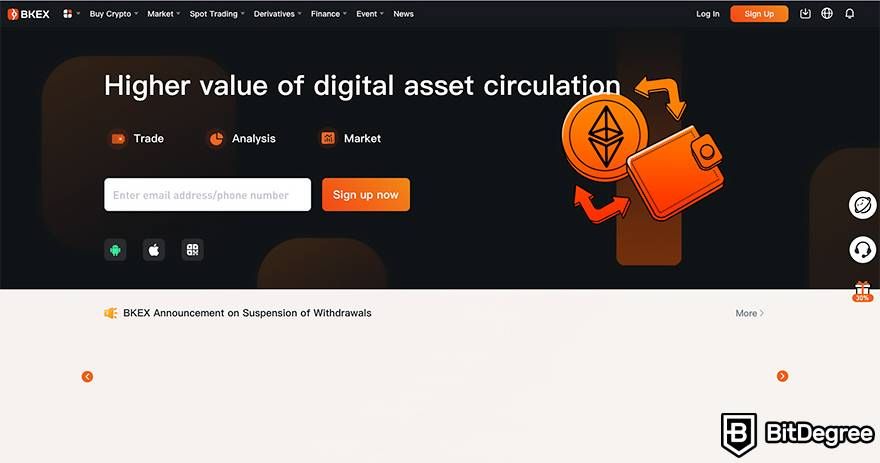
Moreover, it had the Welfare Hub that provided users with various discounts and rewards. Additionally, it offered mining and staking options. When it comes to mining, you could participate in Express Mining or Hashrate Mining. We’ll look into them in more detail further in this BKEX review. Talking about staking, BKEX allowed ETH 2.0 and other cryptocurrency staking.
Lastly, it’s worth noting that BKEX had its own native token called the BKK token. It was a utility token that allowed users to access BKEX's services, provided discounts on fees, and was used for voting in the BKVoting program.
That being said, let’s delve deeper into this BKEX exchange review and explore the intricacies that the platform offered its users.
BKEX Review: PROS
To begin this BKEX review on a positive note, let’s first explore the strengths it had. This will help us understand what features and aspects made it significant in the crypto trading space, and attracted its user base, before the disappearance.
Had a Reputation for Being Secure
Security is one of the most important things to look into when searching for a reliable crypto exchange. After all, I’m sure you want your funds to be safe and your private information to stay, well, private.
BKEX claimed to be a secure crypto exchange as it kept the majority of user funds in a multi-signature cold wallet. The fact that it’s a cold wallet means that it wasn't connected to the internet. In theory, it made it practically impossible for hackers to access it and steal BKEX users’ funds.
Speaking of cold wallets, I suggest getting one (like Ledger Nano X) for storing cryptocurrencies safely on your own account. The story of BKEX acts as a huge proponent of that.
Getting back to the BKEX review, it’s also worth noting that the exchange had insurance funds and used an automatic deleveraging system (ADL). Insurance funds are used to raise the price of unfulfilled liquidation orders and cover bankruptcy losses, while the ADL system automatically deleverages the positions of traders when needed.
This is an interesting point to consider today, seeing as none of the users of the exchange appear to have been compensated for the tokens kept on the exchange. Naturally, it begs the question of whether or not the insurance funds actually existed.

BKEX had also introduced the Abnormal Price Protection plan. It primarily served as a compensation strategy for users who traded at abnormal prices caused by market volatility. The plan made up for the partial spread loss brought on by these prices.
Lastly, when it comes to security and privacy, we should also address the BKEX KYC topic. So, did BKEX users have to undergo the KYC process? Yes and no. No, as they were able to use the platform and withdraw up to 2 BTC worth of tokens per day without it. Yes, because as long as they wished to raise the withdrawal limit, they needed to go through the KYC process.
There were two levels of BKEX KYC – Basic Identity Verification and Advanced. The former increased the withdrawal limit to 60 BTC per day, while the latter to 150 BTC per day.
Now, the option of trading and withdrawing without KYC was good if you were searching for an exchange that provided you with complete privacy. However, the lack of KYC could lead to the aforementioned Anti-Money Laundering (AML) issues, which were exactly what put BKEX in hot water (I’ll elaborate even more on that later).
Various Trading Options
If you've read other BKEX reviews, you've probably noticed that it had a huge variety of trading options like spot and derivatives trading, ETF trading, API trading, and much more, which put it on par with the most well-known exchanges like Binance or KuCoin.
For starters, it allowed users to buy and sell crypto using fiat through the Express Buy feature, P2P trading, or third-party payment channels. The fiat currencies supported by BKEX included THB, USD, EUR, AUD, GBP, and RUB.
Moreover, BKEX’s spot market supported over 1,200 crypto assets, including Bitcoin (BTC), Ethereum (ETH), Binance Coin (BNB), Ripple (XRP), and many others. Spot trading is the most basic form of trading that essentially allows you to buy one crypto asset by selling another at an agreed price, on an agreed date. Besides, you could place limit, market, and trigger orders.
Another trading option that was offered by BKEX that is also related to spot trading were leveraged tokens. These tokens are cryptocurrency derivatives that provide leveraged exposure to specific crypto assets on the spot market without facing the risk of liquidation.
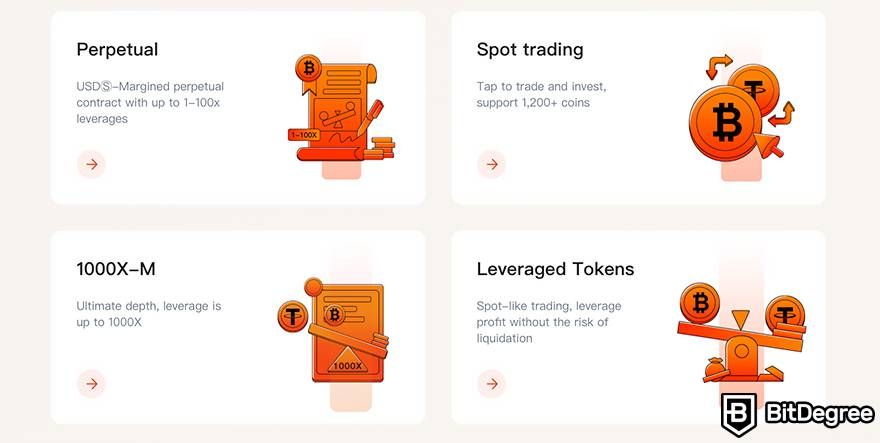
Now, speaking of derivatives, BKEX allowed the trading of USDⓈ-Margined perpetual contracts with up to 100x leverage. These contracts were USDT-quoted and -settled linear futures. One of the major advantages of USDT settlement is that you can quickly compute your (hopefully) profits in fiat.
Additionally, BKEX also offered 1000X-M contracts that allowed up to 1000x leverage and unlimited depth. However, keep in mind that leveraged trading is very risky as it can bring great profits but even bigger losses. So, always evaluate your risks and don’t try to bite off more than you can chew.
If you’re not particularly experienced in derivatives trading, BKEX offered several options for copy trading. To be more precise, it offered derivatives trading and Prin GUAR copy trading.
Derivatives copy trading is pretty self-explanatory - you can copy derivative trading strategies of other experienced and successful traders. But what is Prin GUAR copy trading?
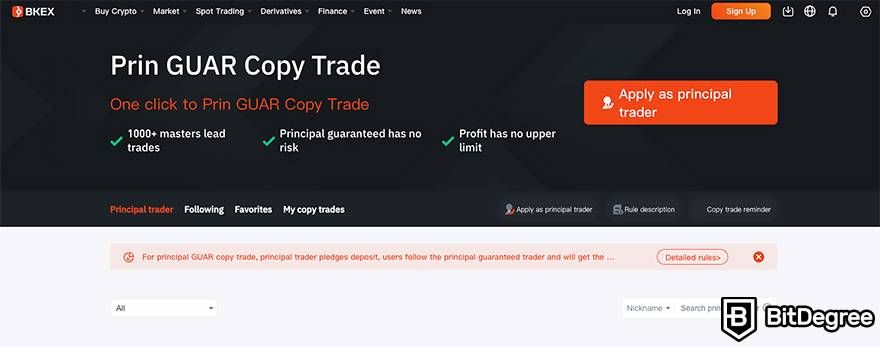
Essentially, a copy trade started by a Prin GUAR trader (the one who is copied) guarantees to protect the user's subscription principal (the one who copies) and to provide compensation if the copy trade is unsuccessful. On the other hand, if it is successful, the Prin GUAR trader gets a bonus from that trade.
Lastly, if you’re not really experienced in derivatives trading, but don’t really want to copy others, BKEX offered demo derivatives trading. It's a simulation-type of trading that allowed you to practice derivatives trading strategies on the real market but with fake funds (BKUT demo tokens). So, you could think of this as a playground for learning derivatives trading.
Latest Binance Coupon Found:Sign up on Binance and claim up to $600 worth of rewards for completing simple tasks. Use Binance referral code (49316610) to activate the offer while it's still valid!
Mining and Staking
As you already know, apart from offering a bundle of trading options, BKEX also provided users with mining and staking possibilities. Both of these were highly discussed features in many BKEX reviews. Talking about mining, there were two main options - Express Mining and Hashrate Mining.
Express Mining was employed in the BKEX Smart Pool, meaning it was essentially liquidity mining. It was further split into four types: flexible mining, short-term mining, fixed mining, and launchpool mining (new currency mining).

Flexible mining was employed by depositing assets in various mining pools. With this type of mining, you could withdraw and deposit crypto assets whenever you want. Mining rewards were distributed daily. The more assets you deposited into liquidity pools, the more rewards you’d be able to earn.
Short-term mining was also employed by depositing assets in mining pools. However, it yielded slightly higher rewards than flexible mining, and you had to keep them locked for at least 1-3 days (depending on the asset in question). Rewards were given out daily, but you could only claim the ones you earned the day before.
Fixed mining yielded even higher returns than short-term mining, but it also required locking your assets for at least 7 days (or more). The rewards for this type of mining were given out periodically, and they depended on the length of time your assets were locked up, as well as the rate of return. You could deposit crypto assets whenever you wanted, but you could only withdraw them once the pool expired.
When it comes to Launchpool mining, BKEX would select several new projects and allow users to participate in their early token mining simply by staking specific crypto assets. Rewards were distributed daily.
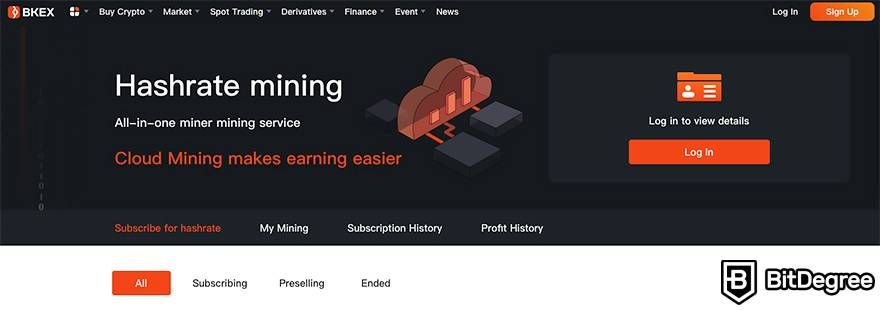
Now, what was the deal with Hashrate Mining?
Put simply, it was an all-in-one cloud mining service that allowed miners to rent processing power instead of building their own mining rigs (which can get pretty expensive). However, when participating in cloud mining, they did have to share mining rewards with others (which wouldn't be the case with solo mining).
Lastly, BKEX offered ETH 2.0 staking (though they refered to it as ETH 2.0 Mining). This is one of the features that stood out in many BKEX exchange reviews. ETH 2.0 is the upgraded version of Ethereum that emerged once the network switched from Proof-of-Work (PoW) to Proof-of-Stake (PoS) during the Merge.

Overall, ETH 2.0 staking is pretty competitive and usually has strict requirements - you have to stake at least 32 ETH and lock your assets for at least 2 years. BKEX, on the other hand, allowed users to participate in ETH 2.0 staking with as low as 0.1 ETH, and you could stake and unstake anytime you wanted.
You could allegedly earn up to 20% APY through ETH 2.0 staking. The yields were distributed in XETH, which was an asset that acted as ETH 2.0’s Proof-of-Reserve. Once you wanted to withdraw your returns, you would just have to swap XETH for ETH at a 1:1 ratio.
Additionally, note that BKEX allowed the staking of other crypto assets as well.
Many Ways to Earn Rewards and Discounts
Another feature that was highly boasted in many user BKEX exchange reviews was the Welfare Hub (Rewards Hub). It offered a variety of promotional initiatives, such as sign-up bonuses and trading rewards. The Welfare Hub had four main offers – beginner demo coin, first deposit coupon, Prize Wheel, and trading bonuses.

The beginner demo coin was dedicated to new users. They could simply claim the BKUT demo coin for free. This coin could be used in BKEX’s derivatives demo trading.
The first deposit coupon was also dedicated to new users. The coupon was worth 10% of the deposited value (but couldn't exceed 50 USDT). There were three conditions for getting this coupon:
- You had to deposit at least 100 USDT into derivatives within three days of your registration.
- You could not withdraw any funds during this period.
- Your cumulative trade volume across copy trading, perpetual futures, and 1000X-M contracts must have reached at least 10,000 USDT.
Now, the Prize Wheel could be utilized by all BKEX users. It claimed to yield rewards with each spin. In order to spin the Wheel, however, you had to possess 5 fire points. To get these fire points, your daily trading volume must have reached 50,000 USDT. Besides, keep in mind that you had to claim fire points manually each day – if you didn't, you’d lose them.
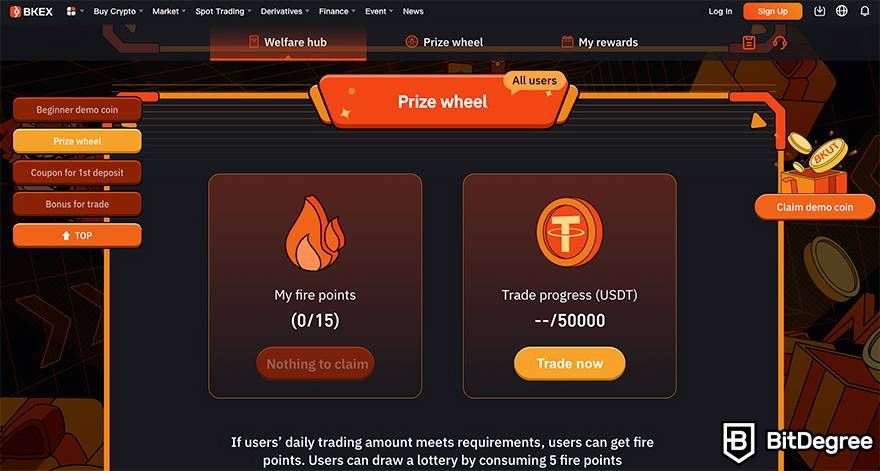
The last offer of the Welfare Hub were the trading bonuses. You could claim these bonuses if you managed to generate a certain amount of tradeing volume during a certain amount of time. There were three bonuses, in total:
- 30 USDT if you reached a trading volume of 300,000 USDT within 5 days.
- 75 USDT if you reached a trading volume of 2,000,000 USDT within 10 days.
- 150 USDT if you reached a trading volume of 8,000,000 USDT within 15 days.
Now, besides the Welfare Hub, another prominent reward-yielding feature that is mentioned in many BKEX reviews was the New Sheik Plan. Though, while this program offered great rewards, it wasn't that easy to become a part of it.

First things first, what was this program about? Well, as the New Sheik, you had to participate in the launching of new projects, as well as submit at least two proposals for new projects related to spot or derivatives trading each month.
In addition to that, you had to hold monthly online/offline events related to BKEX, actively participate in the community (for at least 2 hours per day), and, overall, maintain and promote BKEX’s brand. So, basically, you had to become BKEX’s promoter.
There were four New Sheik plan levels: Bronze, Silver, Gold, and Diamond. You would begin with the Bronze level, and could go up if you manage to successfully facilitate high-quality project listings. To reach the Diamond level, you had to facilitate 10 project listings.
What did you get for being the New Sheik? A lot, actually! You got up to 50% discounts on the BKK price, up to 50% rebates of spot and derivatives trading fees, exclusive gifts, VIP perks, and an exclusive medal of honor. Besides that, you got the ability to be the first to test out new BKEX features, discuss popular projects with BKEX members, and even attend closed-door meetings with BKEX’s founders.
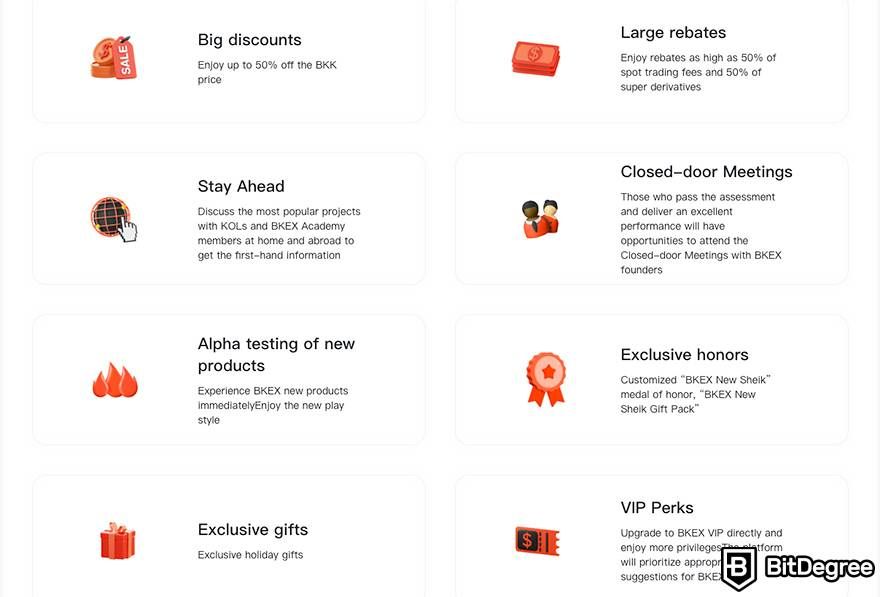
It all sounds pretty cool, right? Well, yes, it does, but, as I said, it wasn't that easy to become the New Sheik. You must have had a crypto community with at least 300 members or a social media account with more than 2,000 active followers. Also, you had to always stay up to date with the latest events in the crypto industry and be an active member of various crypto communities.
Additionally, keep in mind that, technically, you could serve as the New Sheik for no more than 3 months. However, if you were successful during these months and you genuinely wanted to keep this position, you could have tried passing the rigorous BKEX assessment, and you might have been able to extend your time as the New Sheik.
The last thing that's worth noting in this BKEX review when speaking of ways to earn rewards and discounts is that it had a referral program. The program allowed you to earn up to 20% rebates on spot and ETF trading fees simply by bringing new users to the platform. Besides that, BKEX planned to launch the Bug Bounty program, which would have rewarded users in USDT for reporting security bugs and other issues.
Competitive Trading Fees
Many BKEX reviews claims that it offered pretty good fees. Did it, though? Well, the standard trading fee for makers was 0.15%, while for takers, it was 0.2%. By increasing your 30-day trading volume and BKK token holdings, you could have gotten discounts on these fees. So, all things considered, it did offer pretty competitive fees.
However, when it came to ETF trading fees, they'd get a bit higher – makers were charged 0.3%, while takers were charged 0.4% in addition to the dynamic management fee.
What about BKEX withdrawal fees? Like it is with most exchanges, BKEX withdrawal fees were dynamic and depended on the asset in question. For example, if you wanted to withdraw Bitcoin, you had to pay a 0.0005 BTC fee. Or, if you wanted to withdraw BNB, you had to pay a 0.01 BNB fee. Deposits, on the other hand, were completely free.

Did you know?
All Crypto Exchanges may look similar to you but they're NOT all the same!
BKEX Review: CONS
Those were some of the main features and benefits that made BKEX popular, and that attracted users to the exchange.
Evidently, the platform had some cons associated with it, as well - we'll look through them in a sec. Before that, I want to emphasize something - as you can see from the list of features discussed above, BKEX really did seem to have a lot to offer to its users. At the same time, knowing what we know now, it's evident that you need to do some really good research before using an exchange, and make sure to stay with the industry leaders, such as Binance, Coinbase, and Kraken.
Could Not be Used in the US
One of the most noteworthy drawbacks you’ll see pointed out in many BKEX exchange reviews is the fact that it wasn't accessible to US-based users. Of course, if you’re not based in the US, it wasn't really a drawback to you.
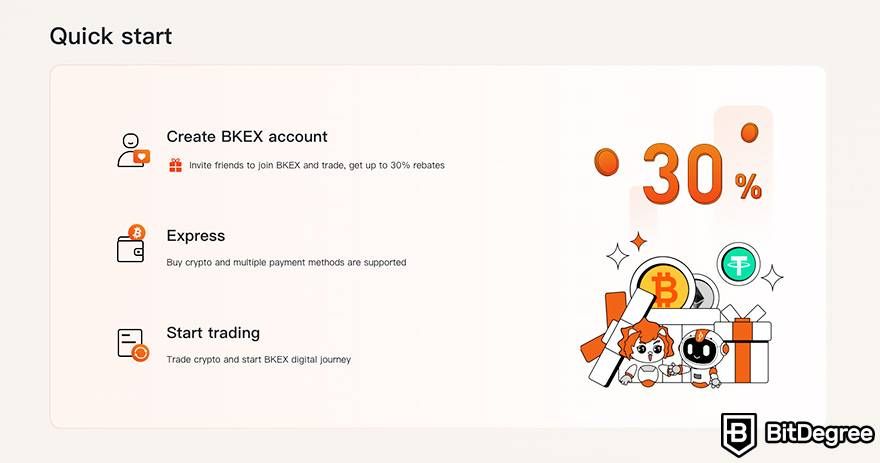
The only way it could be seen as a drawback for non-US users is if we considered the fact that it limited the potential number of users BKEX could attract from the US and, in turn, the amount of trading volume it could generate.
Though, admittedly, quite a lot of cryptocurrency exchanges face this issue as the US has very strict requirements when it comes to crypto trading. Thus, if you’re searching for an alternative to BKEX that can be used in the US, you should check out Coinbase, Kraken, or other options you can find on this "Best US Crypto Exchanges" list.
KYC-Related Issues - BKEX Vanishing
Now, earlier in this BKEX review, I told you about the whole BKEX KYC situation and how it was both a blessing and a curse that you didn't have to undergo the KYC process to use the platform and withdraw up to 2 BTC per day.
Sure, this level of privacy was great, especially as it added to the whole decentralization concept of the crypto world. However, total privacy can become a dangerous tool when wielded by those who have bad intentions. And, unfortunately, BKEX had to learn it the hard way.
As I mentioned in the beginning of this article, in May 29, 2023, it was announced that BKEX had to "temporarily" suspend crypto withdrawals due to alleged involvement in money laundering activities. However, the BKEX team stressed in their official statement that they were actively collaborating with relevant authorities to address these problems and that their top priority was to provide the greatest possible protection of user rights during that time.
Well, a year later, and the exchange appears to have vanished, completely. Looking through its social profiles, it's evident that some users still believe (hope) that BKEX will come back, but as time goes on, there are fewer and fewer indications of that actually happening.
What Did the Signup Process Look Like on BKEX?
Seeing as I went through the process of registering on BKEX while the exchange was still available to be reached, I thought I'd include this section in my BKEX review, as well. Who knows - perhaps if the exchange does come back one day, and you decide to check it out, the process would look the same, so you'll have this text for reference.
Step 1: In the top right corner of the BKEX exchange homepage, you'd find the "Sign Up" button and click on it. Once you did that, you’d be taken to the registration page, where you could sign up using your email, phone number, or even Apple ID and Telegram account.

Step 2: Let’s say you went with the old-fashioned email option. You'd fill it in and then come up with a password. Your password would need to contain lower and upper case letters, as well as numbers (going with something like Ilovecrypto123 would be a bad idea, no matter where you're registering). You could also put in a referral code (if you had one). Then, you just had to read Service Term and Privacy Policy, agree to it, and click “Create account.”
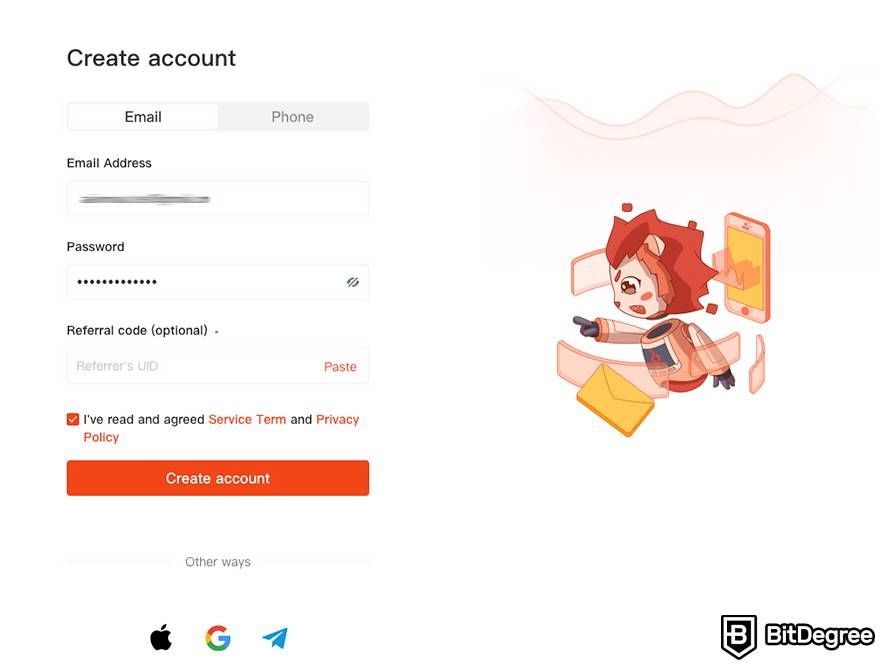
Step 3: Once you did all that, you’d have to complete CAPTCHA to prove that you’re not a robot. All you needed to do is slide the figure where it should be.
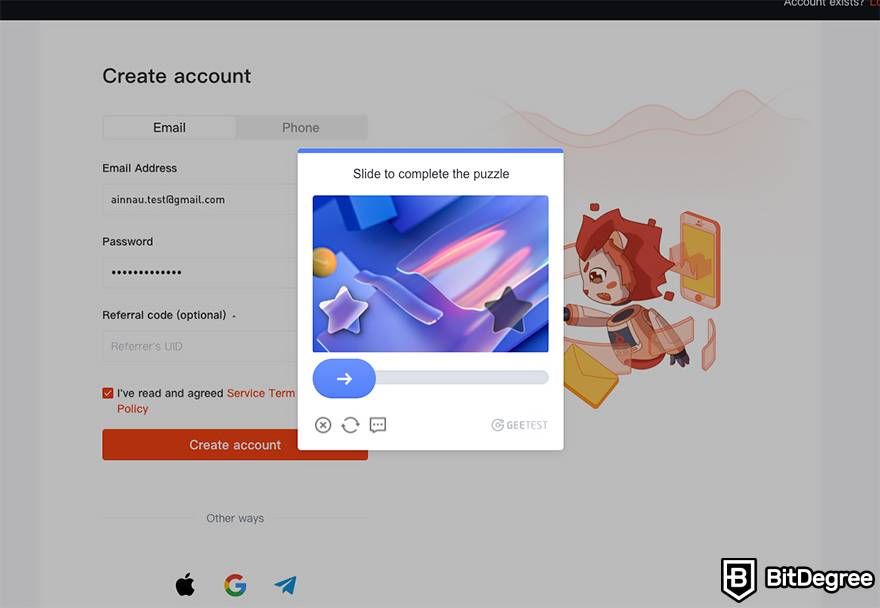
Step 4: Now, you’d have to type in a 6-character code you received to the email you’ve registered with. If you didn't get the code after one minute, the “Get Code” option would appear. The code would be valid only for 5 minutes.

That’s it! You would now be able to start trading, mining, or staking crypto on the BKEX exchange, since you didn't have to pass the KYC process for doing that. Ironic, given the present situation.

- Secure and reliable
- Accepts fiat currencies
- Lots of trading options
- Reputable exchange
- Accepts fiat currencies
- Offers various trading options

- Fiat currencies - accepted
- Simple to use
- Accepts only the most trustworthy cryptocurrencies
- A leading cryptocurrency exchange platform
- Best for beginner investors
- Accepts fiat currencies

- Beginner-friendly
- Secure
- Decent trading and withdrawal fees
Conclusions
Admittedly, this was a very unorthodox review to write - I've checked out BKEX while it was still operational, and found a lot of benefits and cool features associated with the exchange.
At the same time, the exchange is frankly gone, and there are no indications that it'll be coming back, anytime soon.
I've contemplated on publishing this BKEX review, to begin with, but ultimately decided that it's worth discussing the pros and cons of the platform (what they used to be, at least), so that ex-users and enthusiasts could have a better grasp of what the exchange was like, while it was still operational.
Remember - the crypto market is volatile, and there's always a lot of unpredictability involved. To have the best chances of protecting your assets, make sure to use hardware crypto wallets (such as those offered by Ledger), and utilize the services of only the top-rated and most reliable exchanges, with Binance, Coinbase, and Kraken being a few common examples.
The content published on this website is not aimed to give any kind of financial, investment, trading, or any other form of advice. BitDegree.org does not endorse or suggest you to buy, sell or hold any kind of cryptocurrency. Before making financial investment decisions, do consult your financial advisor.






